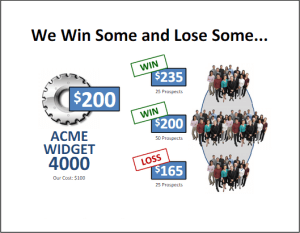For those who might not have noticed the “Question for the Author?” widget in the sidebar of the PricingBrew Journal interface, this functionality allows subscribers to ask questions specific to any webinar, tutorial, guide, or tool in the Library.
As the Editor in Chief, I really like this feature because it provides yet another window into what our subscribers are doing and what they’re grappling with…and because our subscribers ask some fantastic questions!
Take this question, for example…
In the past, our salespeople have basically priced wherever they felt they needed to, as long as they stayed above the floor price we set for each product. Beyond those floor prices, we’ve never really had a price segmentation model to guide reps’ pricing actions. But we’re currently working to put one in place. Our question at this point is about how many segments we should be aiming for? Are there any rules of thumb?
Now, I find questions like these to be very encouraging…
I mean, regardless of where they’re at right now, this pricing team is clearly looking to change the status quo for the better. Of course they realize that they’re a long way from having “Powerhouse Pricing Teams” capabilities. But they aren’t using that as an excuse to sit on their hands…and I’m so proud of them for taking the initiative and pushing for improvement!
Because the answer to the question itself might be beneficial to others who find themselves in the same boat, I’ll try to paraphrase what I told this team…
Ideally, you would have as many price segments as it takes to accurately describe when, where, and why there are meaningful differences in willingness-to-pay across your marketplace.
While this might sound like a wishy-washy answer, it’s true nonetheless. Your “ideal” price segmentation model might have millions of segments, depending on the number and variety of products, the number and variety of customers, the competitive landscape, the variety of buying situations and circumstances, etc.
But the “ideal” can be achieved over time. It’s not something you have to aim for right off the bat…particularly when you’re starting from scratch and putting a model in place where none has existed before. So, you can get started with a somewhat “coarse” segmentation model and plan to add refinements over time.
It’s also useful…and much easier, in my opinion…to think in terms of segmentation attributes, rather than the sheer number of segments involved.
In the situation described in the question, only one attribute is currently being used to differentiate prices—i.e. the product. So, if you have 500 different products, you have 500 different price segments. But if you add just one more segmentation attribute…say, customer type…and let’s say there are six customer types that matter…you’ll end up with 3,000 price segments (500 products x 6 customer types).
You’ve increased the sheer number of price segments significantly…but yet you’ve really only added one additional attribute or consideration into the mix.
The trick, of course, is to identify the attributes that matter most and get started with those. It’s not uncommon for two or three foundational attributes to provide 70-80% of the power in a price segmentation model. And over time, you can consider adding a few more attributes to refine the model, tap into the remaining 20-30%, and get closer to that “ideal”.
As I explained to this team, when you’re developing your first price segmentation model, it’s a good idea to focus your efforts on getting that small handful of foundational attributes right. From there, the number of segments you’ll end-up with is really just a math function…and not a goal unto itself.
And like this team, if you find that you need some advice or other perspectives along the way, don’t hesitate to ask…that’s what we’re here for!
















